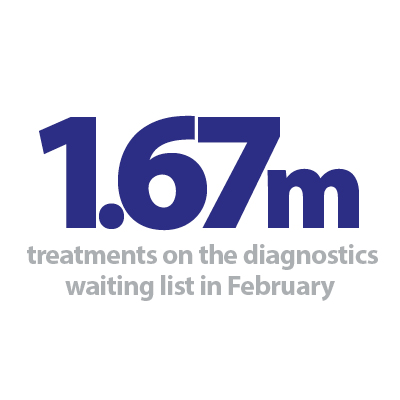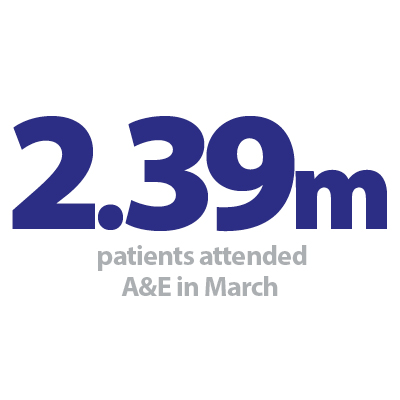


Key points
- Demand remains high across urgent and emergency care with record A&E attendances for the month of March.
- Signs of stretched capacity throughout hospitals continue, with discharge delays higher than last year and measures of patient flow, such as 12-hour waits related to A&E, remaining high.
- Record February levels of diagnostic tests carried out, and the elective waiting list fell for the sixth month running as trusts work to boost activity across planned care
- Performance standards in A&E and diagnostic waits over six weeks are moving in the right direction.
- In some areas performance went beyond current targets, with the highest ever 28-day faster cancer pathway performance recorded in February.
A&E
- It was the busiest March on record for A&E attendances - 2.39 million. (See figure 1.) Three-quarters (75%) of patients were seen in four hours, up from 73.4% last month, but falling short of the 24/25 planning guidance aim of 78% by March 2025.
- There were 551,130 emergency admissions in March, lower than a year ago and before the pandemic in 2019.
- 46,770 patients waited at least 12 hours from the decision to admit to admission in March, down from January's peak (61,500) but still 142 times higher than the January before the pandemic.
- 137,070 patients waited more than 12 hours from arrival at A&E in March (10% of attendances), down from highs of over 176,000 seen in January but still highlighting that too many patients are facing long delays.
Figure 1
Monthly A&E attendances

Acute discharge delays
- The proportion of patients remaining in hospital at the end of each day despite no longer meeting the criteria to reside was 58.2%, higher than last year (54.1%).
Elective waiting list
- The elective waiting list reduced slightly (26,160 fewer treatments) for the sixth month running, and was at 7.4 million in January. This is 2% smaller than it was a year ago but is 62% greater than five years ago in January 2020, before the pandemic.
- Waits over 18 weeks fell by 34,840 to 3.02 million treatments waiting more than 18 weeks, equivalent to 59.2% of all waits. The planning guidance sets out an aim for 65% of treatments to be waiting no longer than 18 weeks by March 2026.
- 193,520 treatments had been waiting over 52 weeks in March, totalling 3% of all waits. The planning guidance target is for waits over a year to make up 1% of all waits by March 2026.
Cancer
- Monthly activity across all three pathways (28-day faster diagnosis standard, 31-day and 62-day) in March was broadly similar to last year.
- Four in every five patients with an urgent referral (80.2%) were told they have cancer, or it was excluded within 28 days in March – the highest proportion ever recorded for this pathway. Trusts had already exceeded the target 28-day faster diagnosis standard (FDS) of 77% by March 2025.
- With 67% of referrals meeting the 62-day standard this month, trusts are still falling short of the target of 70% by March 2025, as set out in the planning guidance.
Figure 2
Percentage of patients seen within 28-day FDS pathway and 62-day pathway standards

Diagnostics
- In February 2025, 2.33 million diagnostic tests were carried out, the highest February figure on record and an increase of 4.1% on last year.
- Despite record levels of activity, demand for diagnostic testing is high. The diagnostic waiting list increased this month to a record 1.67 million, up by 3.5% compared to a year ago.
- In March 2025, 17.5% of patients waited for longer than six weeks – the lowest proportion since March 2020 – highlighting trusts increased capacity for diagnostic testing in the face of rising demand.